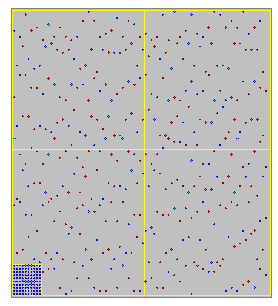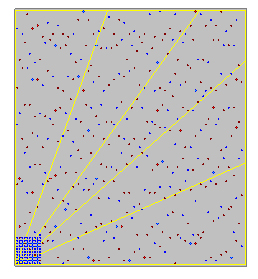
Redistricting Reform
Florida's ballot initiatives would actually make things worse.
-- Dr. Daniel E. Loeb
Having done research on the mathematics of voting, I was at first glad to see
Fair Districts Florida striving to put redistricting reform on the ballot.
After all, Florida is a poster child for Redistricting Reform. Rep. Alcee
Hasting's district (FL 23), for example, has odd tentacles reaching into
Deerfield Beach, Pompano Beach, Fort Lauderdale and Miramar.
Unfortunately, although redistricting is a serious national problem, Fair
District Florida’s proposed amendments to the Florida State Constitution not
only fail to address the current situation, they will make matters worse. Here
are the key elements of Referendums 5 and 6:
- No apportionment plan or individual district shall be drawn with the intent
to favor or disfavor a political party or an incumbent; and districts shall not
be drawn with the intent or result of denying or abridging the equal opportunity
of racial or language minorities to participate in the political process or to
diminish their ability to elect representatives of their choice; and districts
shall consist of contiguous territory.
- Unless compliance with the standards in this subsection conflicts with the
standards in subsection (1) or with federal law, districts shall be as nearly
equal in population as is practicable; districts shall be compact; and
districts shall, where feasible, utilize existing political and geographical
boundaries.>
The first clause judges redistricting plans not on their effect but by their
alleged motivation, turning redistricting into a “thought crime.” A
redistricting plan requires input from scores of legislators, staff, and
consultants familiar with statistics and demographic data. One could allege any
of these participants of being motivated by political bias, and the
redistricting plan would be rejected as a result. Inevitably, all discussion of
the redistricting plan would have to be done off the record.
Moreover, a redistricting plan inherently has serious political consequences
which if ignored will lead to elections which are not competitive, and whose
results do not reflect the will of most voters.

|
|
Hypothetical state redistricting with compact congressional
districts respecting city boundaries.
| |
Here is a simple illustrative example: Consider a typical state with 5,000,000
residents to be divided amongst five Congressional Districts. One million live
in a densely populated city in the Southwest corner of the state, and the
remaining four million are spread out in four rural counties. Suppose the city
is 95% Democratic while the rural counties are 60% Republican, as illustrated in
the figure to the left. (Red dots represent 10,000 Republican voters while blue
dots represent 10,000 Democratic voters.) Overall, the state has slightly more
Democrats than Republicans (2,550,000 vs. 2,450,000). Suppose political voting
patterns were truly ignored in drafting a redistricting plan of a hypothetical
state, and borders were based only on existing geographical boundaries and
compact districts. The most compact districts would arise by making the city its
own district and making each county its own district. The four rural counties
would not be competitive since the Republican candidate starts with a 20%
advantage in registration over his Democratic rival. The sole urban district
would be even less competitive: with 95% of the voters registered as Democrats,
the Republicans may not even bother to field a candidate. As a result, the
state's congressional delegation would be dominated 4:1 by Republicans even
though the state has a Democrat majority. Moreover, because the districts are
all so imbalanced, the Congressmen representing the districts will be
virtually guaranteed reelection (just as
98% of House incumbents seeking reelection succeeding in doing in 1988).
Without any doubt about their political future, politicians can ignore the needs
and desires of their constituents

|
|
Alternate redistricting plan for the same hypothetical state
with more competitive congressional districts.
|
|
On the other hand, if the state was divided into sectors as shown here, the
districts would be five less-compact wedges which do not respect existing
city/county boundaries, but are each extremely competitive (with 510,000
Democrats and 490,000 Republicans in each district). In such well-balanced
districts, all candidates would have to campaign aggressively and be extremely
responsive to his or her electorate once elected.
This example is not at all contrived; rather, it is typical of the situation in
most states. Democrats tend to dominate in densely concentrated urban areas to a
far greater extent than Republicans do in suburban and rural areas.
A sensible redistricting plan should take voting patterns into account. The State
Constitution can then mandate competitive districts which in their aggregate
reflect the political and ethnic makeup of the state. Iowa, for example, has
adopted meaningful redistricting reform by taking redistricting out of the hands
of the legislature and empowering a non-partisan redistricting commission. As a
result, there are more competitive Congressional districts in Iowa than in
Pennsylvania, New York and California combined! My own state, Pennsylvania, is
considering adopting a
similar plan.
Unfortunately, Fair District Florida’s proposed amendments do not achieve the
goal of creating balance, competitive Congressional districts . I fear that
passing well-intentioned but poorly-designed referendums will delay any serious
attempts at meaningful redistricting reform.
Dr. Daniel Elliott Loeb has a Ph.D. in mathematics from MIT. His research
interests include the mathematics of voting, mathematical finance, statistics
and game theory. He was the recipient of a NATO Collaborative Research Grant, a
National Science Foundation Research Fellowship and a tenured research position
in Computer Science with the French CNRS.
Did you enjoy this article?
If so,
- share it with your friends
so they do not miss out on this article,
- subscribe
(free), so you do not miss out on the next issue,
-
 donate
(not quite free but greatly appreciated) to enable us to continue
providing this free service. donate
(not quite free but greatly appreciated) to enable us to continue
providing this free service.
If not,
|